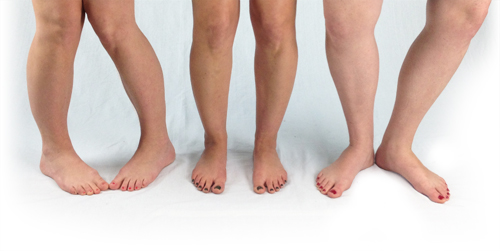How Are You Working: Legs turned Toe-Out, Parallel, or Pigeon?
This article is Part 2 in a 3-part series on Healthy Feet: Heel Mobility for Better Balance & Body Control
 Little, seemingly insignificant posture habits can set you up for problems, pain and injury. And what is interesting is the fact that your heels and ankles might not be the weak link that is setting you up for a potential problem. What do I mean by this?
Little, seemingly insignificant posture habits can set you up for problems, pain and injury. And what is interesting is the fact that your heels and ankles might not be the weak link that is setting you up for a potential problem. What do I mean by this?
Part of paying attention to leg alignment is knowing what is happening at the feet. A toe-in, parallel or toe-out stance or gait pattern can dramatically change how the feet and ankles work and affect the stress placed on your knees and lower back. As a result of your everyday foot fitness habits, the muscles that are strong or weak in your feet and lower legs can be your own unique posture challenge.
But half of what you need to pay attention to might be the direction of the feet and the other half is what’s happening at the hip.
Standing, sitting, walking and running with your ankles rolled out (or in), or your feet toe-out (or toe-in) can create muscle imbalances, but it might not be your feet that hurt as a result. There’s a good chance that instead of foot pain the pain or injury will be at your knees, hips or lower back.
If you go to your doctor or get referred to physical therapy and they only address what hurts (your knee, hip or back) but do not evaluate your whole body to discover the root of the problem, (your feet, ankles and heels or the relationship between your hips and heels) finding a lasting solution may be a challenge.
So if you have heel pain, you might need to focus on your feet, or you might get more lasting relief by working on better functional movement from the hips. And, if your back hurts – perhaps it is your core support, hips and pelvis that need more attention, or improvements in your foot fitness might alleviate your pain.
Sometimes it’s a chicken or the egg dilemma. I know it might sound crazy to start addressing a back problem with your feet, but for positive, lasting changes rather than a temporary “quick fix” paying attention to your foot fitness is priceless. Good body alignment to stand, walk and run starts from our feet. And while there’s more and more information out there for arch exercises, toe exercises and effective calf stretches, how often have you seen or heard anything about specific exercises for your heels?
I’ve had a few clients who are passionate dressage riders. They all have realized the benefits core training and Pilates has to contribute to their sport. The control and body awareness gained can make a significant difference to “become one” with your horse.
And interestingly, almost all of the dressage riders I have worked with have had medial /lateral ankle and heel issues that affected their performance. Hugging a horse with your thighs takes strong inner thighs. But because the legs are wide apart while the inner legs are squeezing, the connection to the feet in the stirrups especially through the inner heels tends to get lost.
Perhaps “lost” is a strong word… But, picture an old weathered cowboy walking down the middle of Main Street. Chances are he still looks like he’s riding a horse. He’s ambling along with extremely bowed legs. I bet if you looked at his ankles and feet you’ would notice that he’s rolled out at the ankle and stands mostly on the outer heel.
You don’t have to ride horses or be bow legged to have similar posture and alignment issues for your feet and ankles. A lot of people have adopted this posture habit. You might sit at your desk all day with your ankles rolled out, or stand and shift your weight to one hip which can roll one ankle in and one out, or with some other sport or unconscious habit reinforce rolling the ankles outward and shortening the inner heel.
We don’t typically spend a lot of time doing exercises with the legs turned inward from the hip, or exercise with the feet in a “Pigeon-toed” position. However, maintaining mobility from the hip to the heels with this leg alignment has value for improving flexibility, balance and body control. There is a different angle of stretch at the ankle for the Achilles tendon that can be achieved in a toe-in position that is beneficial for improving ankle alignment.
If you are like most people the outer hips to turn the legs outward is strong, but we do virtually nothing with the legs in a pigeon-toed, toe-in position. And while this isn’t a great leg alignment position for walking, there are some good benefits for both hip and heel mobility to be able to comfortably turn the legs in and have some movement of the legs and ankles in this position.
Use this simple standing exercise to help improve hip and heel mobility in a toe-in position.
Pulse Power – Pigeon Pulse Exercise
- Stand tall and rotate the legs inward from the hips so that the toes are pointing towards each other.
- Bend the knees as far as you are comfortable. If you have a good range of motion at the hip you will be able to bend and have the knees gently touching to a “snow plow” position.
- Ideally the weight stays evenly distributed on the whole foot (big toe, little toe, inner and outer heel)
- Using the muscles of the hips and the hamstrings begin to slightly straighten and bend the knees in a mid-range pulsing action. Don’t take the legs all the way straight, only go half-way up, and back down to the “snow plow” position.
- Inhale for 3-5 pulses, exhale for 3-5 pulses.
- Repeat for 3-10 breaths.
If your calves are tight and heels need more mobility you might notice a different type of stretch in this position than you get with a typical calf or soleus muscle stretch. And if you don’t notice a stretch at all because of the work happening with your legs to pulse, that’s ok too!
There is another great medial /lateral heel stretch you can do that’s not in a standing position. If it bothers your knees to be in a pigeon position, you might start with this Heel Stretch with a Strap exercise and then progress to the Standing Pigeon Pulse exercise.
For this exercise you will need a strap, towel, scarf or belt. The key to the best Heel Stretch with a strap exercise is to be sure that you are moving your heel and not just your foot. For a great video and step by step instructions for the Heel Stretch with a Strap exercise, click here.
There are lots of great benefits for our feet by having the ability to work in a toe-out, parallel, and pigeon position! Try adding this simple exercise to your workouts for healthy heels.


0 Comments